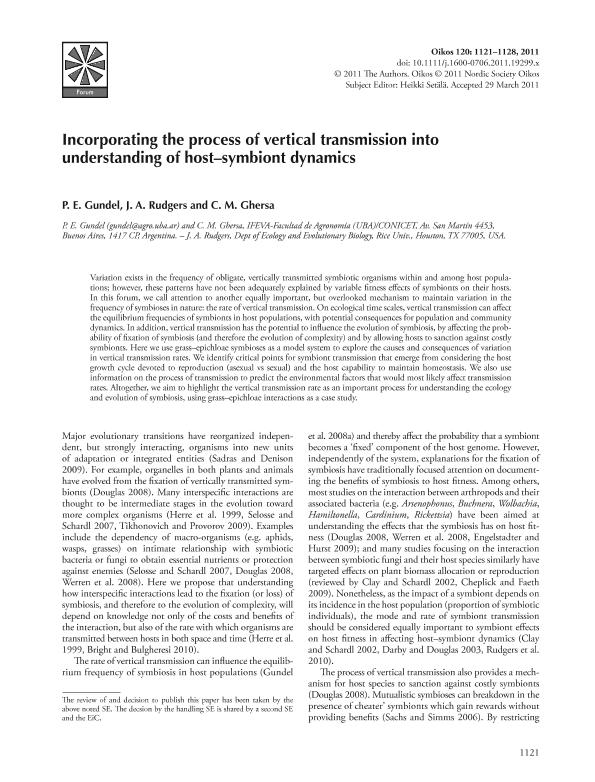Mostrar el registro sencillo del ítem
dc.contributor.author
Gundel, Pedro Emilio

dc.contributor.author
Rudgers J. A.
dc.contributor.author
Ghersa, Claudio Marco

dc.date.available
2020-02-10T19:46:28Z
dc.date.issued
2011-08
dc.identifier.citation
Gundel, Pedro Emilio; Rudgers J. A.; Ghersa, Claudio Marco; Incorporating the process of vertical transmission into understanding of host-symbiont dynamics; Wiley Blackwell Publishing, Inc; Oikos; 120; 8; 8-2011; 1121-1128
dc.identifier.issn
0030-1299
dc.identifier.uri
http://hdl.handle.net/11336/97102
dc.description.abstract
Variation exists in the frequency of obligate, vertically transmitted symbiotic organisms within and among host populations; however, these patterns have not been adequately explained by variable fitness effects of symbionts on their hosts. In this forum, we call attention to another equally important, but overlooked mechanism to maintain variation in the frequency of symbioses in nature: the rate of vertical transmission. On ecological time scales, vertical transmission can affect the equilibrium frequencies of symbionts in host populations, with potential consequences for population and community dynamics. In addition, vertical transmission has the potential to influence the evolution of symbiosis, by affecting the probability of fixation of symbiosis (and therefore the evolution of complexity) and by allowing hosts to sanction against costly symbionts. Here we use grass-epichloae symbioses as a model system to explore the causes and consequences of variation in vertical transmission rates. We identify critical points for symbiont transmission that emerge from considering the host growth cycle devoted to reproduction (asexual vs sexual) and the host capability to maintain homeostasis. We also use information on the process of transmission to predict the environmental factors that would most likely affect transmission rates. Altogether, we aim to highlight the vertical transmission rate as an important process for understanding the ecology and evolution of symbiosis, using grass-epichloae interactions as a case study.
dc.format
application/pdf
dc.language.iso
eng
dc.publisher
Wiley Blackwell Publishing, Inc

dc.rights
info:eu-repo/semantics/openAccess
dc.rights.uri
https://creativecommons.org/licenses/by-nc-sa/2.5/ar/
dc.subject
Transmission mode
dc.subject
Fungal endophytes
dc.subject
plant-endophyte interaction
dc.subject
coevolution
dc.subject.classification
Ecología

dc.subject.classification
Ciencias Biológicas

dc.subject.classification
CIENCIAS NATURALES Y EXACTAS

dc.title
Incorporating the process of vertical transmission into understanding of host-symbiont dynamics
dc.type
info:eu-repo/semantics/article
dc.type
info:ar-repo/semantics/artículo
dc.type
info:eu-repo/semantics/publishedVersion
dc.date.updated
2020-02-07T13:48:41Z
dc.journal.volume
120
dc.journal.number
8
dc.journal.pagination
1121-1128
dc.journal.pais
Reino Unido

dc.journal.ciudad
Londres
dc.description.fil
Fil: Gundel, Pedro Emilio. Consejo Nacional de Investigaciones Científicas y Técnicas. Oficina de Coordinación Administrativa Parque Centenario. Instituto de Investigaciones Fisiológicas y Ecológicas Vinculadas a la Agricultura. Universidad de Buenos Aires. Facultad de Agronomía. Instituto de Investigaciones Fisiológicas y Ecológicas Vinculadas a la Agricultura; Argentina
dc.description.fil
Fil: Rudgers J. A.. Rice University; Estados Unidos
dc.description.fil
Fil: Ghersa, Claudio Marco. Consejo Nacional de Investigaciones Científicas y Técnicas. Oficina de Coordinación Administrativa Parque Centenario. Instituto de Investigaciones Fisiológicas y Ecológicas Vinculadas a la Agricultura. Universidad de Buenos Aires. Facultad de Agronomía. Instituto de Investigaciones Fisiológicas y Ecológicas Vinculadas a la Agricultura; Argentina
dc.journal.title
Oikos

dc.relation.alternativeid
info:eu-repo/semantics/altIdentifier/url/http://onlinelibrary.wiley.com/doi/10.1111/j.1600-0706.2011.19299.x/abstract
dc.relation.alternativeid
info:eu-repo/semantics/altIdentifier/doi/https://doi.org/10.1111/j.1600-0706.2011.19299.x
Archivos asociados
